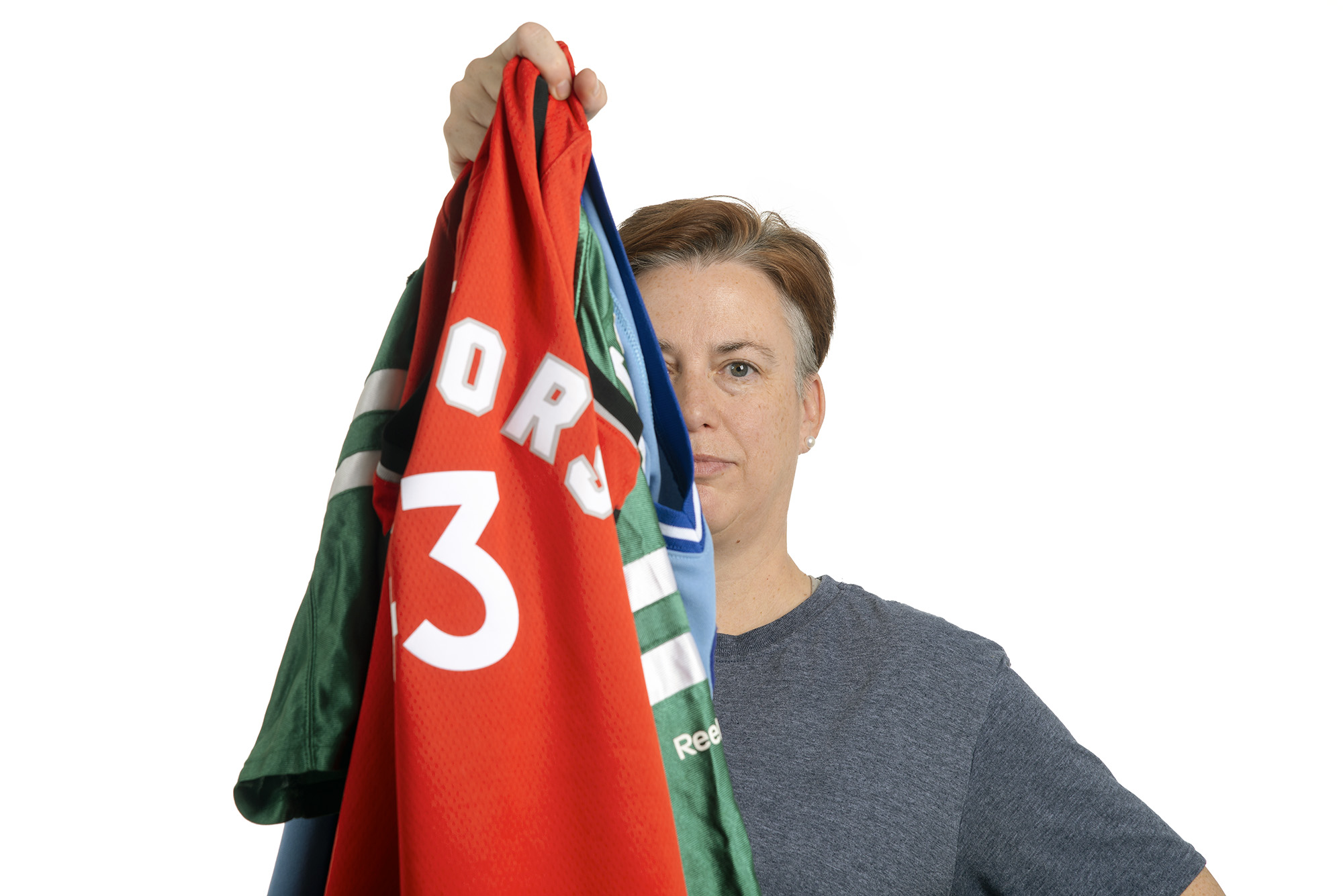Dr. Larena Hoeber is hoping to change the shape of fanwear to be more inclusive.

Dr. Larena Hoeber is on a mission to bring more equity to the sports apparel business – shattering “plexiglass” walls in the process.
This University of Regina researcher is a sports fanatic. Hoeber, associate dean of graduate studies in the Faculty of Kinesiology and Health Studies and a professor who specializes in sports management and the sociology of sport, spent her formative years in small-town Saskatchewan gathered around the glowing lights of the TV watching action-packed games with her family.
No sport was ever missed in the Hoeber household. While other kids were watching MuchMusic, she was gearing up for the latest college basketball game and scheduling in time for the Blue Jays, Saskatchewan Roughriders, Detroit Pistons, and the Summer and Winter Olympics. This superfan loved them all – and more.
As a sports fan, Hoeber would seek out T-shirts and jerseys to show her support for her favourite teams, but, even at a young age, she found the selection in stores was always lacking.

“Women make up about 47 per cent of sports fans, yet fan clothing options for women and gender-diverse people are sadly disappointing. We’re offered an array of sexy, low-cut T-shirts with bling. The focus is on sex appeal and fashion, not functionality,” she says. “So, I’d end up buying the boxy men’s jerseys and T-shirts. Some women decide to buy the men’s shirts, then tailor them to fit rather than opt for the pink or hyper-sexualized gear marketed to female sports fans.”
Armed with her own frustration, Hoeber and her former doctoral student Katie Sveinson decided to apply academic research to the problem.
“We analyzed dozens of National College Athletic Association (NCAA) websites for men’s and women’s team clothing and found that they’re marketed completed differently,” she says.
“Men are seen as the ultimate sports fans, with masculine gear marketed for comfort, with fabric that wicks away moisture. Women’s clothing, on the other hand, emphasizes fashion along with their fandom. We see crop tops, mesh tops, and tube tops, with lots of deep-cut V-necks. It’s as if when you’re a woman and you love sports, your main goal is to show off your body, not support your team in any meaningful way. But what about all those women who just want to demonstrate their love of the game?”
“All women sports fans want is fan clothing that doesn’t suck.”
Hoeber’s and Sveinson’s research is not meant to diss women who want to look sexy on the field, on the sidelines, or in the game – they point to Serena Williams as a powerful athlete who also likes to show her feminine side. But the researchers do think it’s important to realize that all kinds of sports fans are being left out of the equation when these are the only options available.
“We’ve come so far within North American society when it comes to diversity and inclusivity, yet the sports arena seems to be one of the last holdouts where stereotypes abound. It’s as if there’s no room for any other fan out there,” Hoeber observes.
Hoeber says she’s hoping to help eliminate these stereotypes from the ground up. “What about sports apparel that acknowledges that not all men want to wear boxy jerseys? Maybe they’d prefer a more tailored shirt for the office or a night out, or a classy logoed scarf instead. What I’m saying is, not all men who are sports fans are alike, and neither are women, nor gender-diverse fans. That logoed tube top may not work for them, and neither will the boxy jersey.”
More than 3,300 km away, at the University of Massachusetts, Sveinson, who is now an assistant professor in the sport management department, says that around the globe, female sports fans are woefully underserved when it comes to fanwear.
“All women sports fans want is fan clothing that doesn’t suck,” says Sveinson, whose pointed comment blew up on Twitter. "Research has shown women sports fans want and deserve to demonstrate their authentic fandom, but selection in stores and online is really underwhelming – full of pink, bedazzled, sequined, low-cut and too fitted options.”
Hoeber says a huge marketing opportunity exists to expand how people express their fandom.
“Why not cater to African-American culture, or goth culture, or any number of groups or countercultures out there? Sports fans come in every shape, size, gender, and ethnicity,” she adds. “Society isn’t homogenous, and neither are sports fans.”

Hoeber says this aspect of stereotypical fandom has always bothered her. “I always told myself, ‘Well, maybe it will change in 20 years,’ but that was 20 years ago, and things still haven’t changed. I think it’s time for all of us to speak up and make change happen and not accept these traditional stereotypes anymore. We need to demand better of our teams, their merchandisers, and their marketers. Because there’s an entirely underserved market out there for fan clothing.”
Hoeber and Sveinson are quite happy to carry the proverbial hockey stick, go into the boards, and even break some plexiglass walls in the process.
“I’m a woman and I’d love a great sports shirt that fits me and my style,” says Hoeber.
Over in Massachusetts, Sveinson and her team are now researching how mothers are underserved at sports stadiums, with no adequate parent rooms equipped with TVs showing the game.
With plans to extend her research program to fans of women’s sports and fans of teams outside of the United States and Canada, Hoeber is actively rooting for Sveinson and others to pick up the sports equity research mantle.
“Real change is out there. We just have to speak up and get the message out.”












